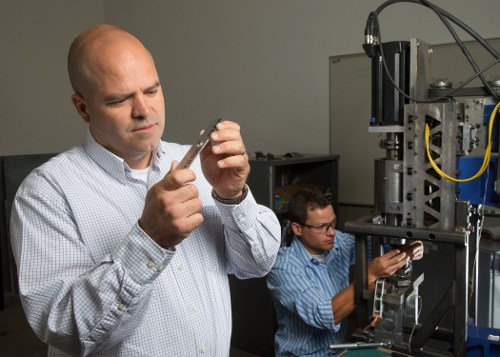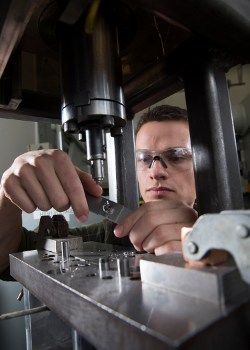 |
| August 13, 2013 | Volume 09 Issue 30 |
Designfax weekly eMagazine
Archives
Partners
Manufacturing Center
Product Spotlight
Modern Applications News
Metalworking Ideas For
Today's Job Shops
Tooling and Production
Strategies for large
metalworking plants
Wheels:
BYU's friction bit joining process aims to help automakers lighten up
New federal fuel-efficiency rules are forcing automakers to lighten up their vehicles -- a task that has proved difficult given the challenge of combining high-strength steels with lighter metals.
But a new method from Brigham Young University's School of Technology may be helpful to automakers in achieving the 54.5-mpg average the EPA is mandating for U.S. fleets by 2025.

Manufacturing professor Michael Miles reviews a newly joined set of dissimilar metals.
Manufacturing engineering technology professor Michael Miles has found a way to successfully create an extremely strong bond between lightweight aluminum and ultra high-strength steel. It's called friction bit joining, and it may be the breakthrough the automotive industry is looking for.
"It's all about making vehicles lighter, and our process can help to combine steels and light metals in the same vehicle frame, which gives engineers more flexibility in designing an optimal structure," Miles said.
The process of friction bit joining uses a small, consumable bit to create a solid-state joint between metals. The method was invented by Miles and retired BYU professor Kent Kohkonen in collaboration with Orem, Utah-based company MegaStir Technologies.
The latest development in the process successfully bonds lightweight aluminum with cast iron by inserting a thin layer of steel between the two metals, which facilitates the bonding process. Findings of this research, carried out in collaboration with the University of Ulsan in South Korea, are published in the June issue of the International Journal of Precision Engineering and Manufacturing. You can read the full article in .pdf format here. [Editor's note: We could not get permission in time to repost the images of the bit joining that are included in the paper. We urge readers to download the paper to see what this process is really about. The visuals are key.]
"The motivation to make cars lighter was already there with a previous EPA mandate (34.5 mpg by 2016), but that motivation has now increased with the latest mandate," Miles said. "Our process is a technical success in the effort to spot join dissimilar metals together; now we need to go forward with our partners to make it commercially viable."

Manufacturing systems grad student Lile Squires bonds metals together with friction bit joining.
Currently, the automotive industry uses resistance spot welding to join steel stampings together into a completed body. In recent years, some aluminum parts have been introduced into the vehicle structure using a mechanical fastening method called self-piercing riveting. While this approach works to join lower strength steels with aluminum, it isn't suitable for joining aluminum to ultra high-strength steel.
BYU's friction bit joining method, which is being developed in collaboration with MegaStir and Oak Ridge National Lab, has received funding from the National Science Foundation, the Department of Energy, the state of Utah, and some auto suppliers in South Korea.
Applications for the process include areas of the vehicle frame where ultra high-strength steel needs to be joined to a light metal.
For example, an automaker may want to use aluminum for the roof of a car while using ultra high-strength steel for the A and B pillars of the frame that connect with the roof. Another example includes the incorporation of lighter weight metals on the interior parts of the car door.
Miles said the ability of friction bit joining to produce "incredible strength between two dissimilar metals" will eventually benefit both automakers and other industries, like aerospace.
"It's great to be working on a project that's making a difference," said Lile Squires, a manufacturing systems graduate student working with Miles. "We know this process could be used in a lot of places."
Source: Brigham Young University School of Technology
Rate this article
View our terms of use and privacy policy
